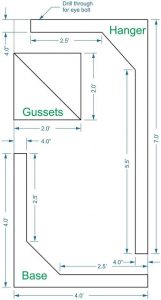
If boxing brings any image, it’s the athlete standing at a punching bag, spending hours working on his swing. Both the peanut bag and the heavy bag are helpful tools in training and practice shadow boxing, tools that can even be used when one doesn’t have a sparring partner to work with. These bags, especially the heavy bags, aren’t just valuable for boxers and those studying martial arts. The ability to have something that absorbs your blows and reels back like an actual opponent can’t be overstated.
Most people buy punching bags and stands, as a basic stand and bag setup isn’t all that expensive. But that’s all they are… basic stuff. You can make yourself a much nicer stand, something that you can be proud of and which will look much better sitting in the corner of your family room, garage, or whatever area you use as a gym.
Choosing the Right Materials for Your Homemade Punching Bag
- PVC pipe is an excellent alternative for the base of your punching bag, providing a sturdy and durable foundation.
- Thick carpet padding or old clothes can fill the bag, providing a comfortable and cushioned surface for punching.
- Duct tape is essential for securing the padding or clothes, ensuring a tight and secure fit.
- Rope or twine can hang the bag, providing a sturdy and reliable mounting point.
- Consider using a heavy-duty or canvas bag as an alternative to a traditional punching bag.
Designing Your Punching Bag
- Measure and cut the PVC pipe to the desired length, ensuring it is sturdy enough to support the bag’s weight.
- Design the bag to fit your needs, whether for martial arts training or shadowboxing.
- Consider adding a reinforced bottom or a weighted base for added stability.
- Think about the size and shape of the bag, ensuring it is comfortable to punch and provides a good workout.
- You can also add a handle or strap to make hanging and moving the bag easier.
Step-by-Step Instructions for Making a DIY Heavy Bag
- Cut the PVC pipe to the desired length and attach the base using duct tape or glue.
- Fill the bag with the chosen material, ensuring it is tightly packed and secure.
- Wrap the bag with rope or twine, leaving enough room to tie the ends together.
- Hang the bag from a sturdy mounting point, ensuring it is secure and level.
- Test the bag by punching it gently, ensuring it is comfortable and provides a good workout.

Tips for Filling and Hanging Your Punching Bag
- Fill the bag with various materials, such as sand, rice, or beans, for a varied and challenging workout.
- Ensure the bag is hung comfortably, allowing you to punch it without straining your back or shoulders.
- Use bag gloves or hand wraps to protect your hands and wrists while punching the bag.
- Consider adding a swivel or a pivot point to the bag. This would allow it to move freely and provide a more dynamic workout.
- Tie the rope ends securely, ensuring the bag is stable and won’t fall or swing wildly.
Common Mistakes to Avoid When Making a Punching Bag
- Avoid using too much material, making the bag too heavy or unwieldy.
- Don’t forget to secure the bag properly, ensuring it won’t fall or swing wildly.
- Avoid using cheap or flimsy materials, which can break or wear out quickly.
- Please test the bag before using it to ensure it is comfortable and provides a good workout.
- Avoid hanging the bag too high or too low, which can cause strain or discomfort.
Safety Precautions and Maintenance for Your Punching Bag
- Always wear gloves and hand wraps when punching the bag, protecting your hands and wrists.
- Ensure the bag is hung securely and won’t fall or swing wildly.
- Regularly inspect the bag for signs of wear or damage, replacing it if necessary.
- Avoid punching the bag too aggressively, which can cause injury or strain.
- Consider adding a protective cover or sleeve to the bag, protecting it from dust and debris.

Ways to Do It
There are several ways of going about this, but there are a few basic requirements for any heavy bag. First of all, it has to be pretty heavy. You’re trying to get that bag to simulate a person’s body that you’re striking, so it needs some weight. Secondly, it needs to be resilient, or it’s just not going to last. That also includes the stand; for example, the stand has to absorb all of your strikes. Finally, the stand has to be sturdy enough so that it isn’t going to move when you hit the bag.
Homemade Heavy Punching Bag
The punching bag itself needs to be fairly heavy and solid but not solid enough that you would hurt your hands when hitting it. It also needs to be strong enough to handle the abuse of being hit hard repeatedly without breaking. All the materials used in making it should be chosen with this in mind.
Carpet Pad Heavy Punching Bag
Carpet padding can be used to make an excellent punching bag for beginners and children. Boxing in this material is easier on the hands, which is necessary for young ones.
To make and create this sort of bag, start with a piece of 3” or 4” PVC pipe. Drill holes in one end to hang it by and attach a plywood disk to the other end; that’s the diameter you want the finished bag to be. This disk must be connected well, as it will keep the carpet pad from sliding off the pipe.
Cut a piece of carpet padding (new or used; make sure glue is removed) to match the width of the PVC pipe, less than 1 inch. You need this inch of extra space at the top to attach ropes through the holes you just made in the pipe. Tape one end of the carpet pad to the PVC pipe with duct tape (to keep it in place) and wrap the carpet pad around the pipe, ensuring that each layer is snug over the previous. If you run out of carpet pads, tape off the end of the piece and add another, taping it in place. Your goal is to get enough pads on the pipe to exactly equal the diameter of half the plywood disk at the bottom end. When you get there, cut off the excess pad and tape it in place.
To add strength and prevent the carpet pad from becoming damaged, cover the carpet pad with a layer of duct tape, one continuous piece, wrapping it from one end to the other and capping the ends. Overlap each layer over the previous by at least 30 percent to ensure good adhesion.
Burlap Sack Heavy Punching Bag
If you can find one, a more solid punching bag can be made from a burlap sack (50 lb. potato sack). Line the burlap sack with a large, heavy-duty plastic bag, such as a lawn and leaf bag. You’ll want the plastic of your punching bag to fill the burlap sack so that the burlap can sit right up against the plastic. The plastic provides a non-permeable layer to keep the stuffing in, while the burlap provides a surface that can withstand being hit regularly.
Start by filling the bottom of the bag with sand to provide weight and stability. You’ll want between 10 and 25 pounds (5-15 kg) of sand. The more sand, the greater the bag’s stability and the less force it will swing when you hit it.
With the sand in place, start filling the bag with sawdust or wood chips. You can buy this from an animal feed store, as it is used for bedding for livestock. If you want to save money, you can probably get all the sawdust you can use for free from a local sawmill or cabinet shop. They are always looking for ways to dispose of excess sawdust.
You want to pack the sawdust into the bag as tightly as possible. Once you have it most of the way full, take a wood pole and push it down, packing it in place. Add more sawdust or wood chips as needed, stopping about 8 inches short of the top of the sack.
Fold the end of the plastic bag over first, pushing out the air and rolling it up until you get down to the level of the filler. Then, tie the bag off, making it as airtight as possible. Then, gather the edges of the burlap sack together and tie it with a thin rope. You’ll want to wrap the rope around the neck of the bag several times, making what is known as a “bag knot” or “Miller’s knot.” You can use the ends of the rope from your miller’s knot to hang the bag or tie a larger piece of rope to the top, just below the miller’s knot.
Duffel Bag Heavy Punching Bag
Almost the same thing can be done with a canvas duffel bag, as we discussed with a burlap sack. The only difference is that you don’t need the plastic bag inside the duffel unless it has small holes. A military-issue duffel bag or something similar is ideal. It is tough and about the right size. Cut the straps, their buckles, and handles off of it, being careful not to damage the bag in the process. Fill it as mentioned above and then close the top. The eyelets in the top can be used for the rope to hang it.
Making a Plywood Stand for Your Heavy Punching Bag
There are several ways of hanging a punching bag. Some people hang them directly from the floor joists when building their gym in the basement. You can also make a reasonable frame from heavy timber, joining them to form an overhead concrete crossbar. But these sorts of stands take up a lot of room, room you may need for other things. It would be nicer to have a stand that can sit in the corner of the room, taking up as little space as possible.
We can make such a stand out of plywood. While we imagine it would be possible to make this out of heavy timbers, it will be lighter and stronger if we make it out of plywood. Two layers of ¾” plywood, laminated together, make a very strong beam. This also allows us to screw into the ends of the pieces, something that doesn’t work well when merely screwing into the end grain. This design also allows us to use very few joints, adding to the strength even more. Typically, the joints on a structure are the weakest points, so we want to minimize those.
Cut two sheets of ¾” plywood as shown on the layout below:

Punching bag plywood stand
Each pair of parts needs to be laminated together. In other words, laminate both base pieces, gluing and nailing them to make one double-thickness piece. Once the glue has dried, sand the edges to even them and remove splinters. It would be best if you ended up with:
⦁ The base
⦁ The hanger
⦁ Two gussets
One edge of each gusset will have to be beveled at a 45-degree angle to sit up flush with the side of the hanger. The two gussets must be different because the slope is at the opposite angle on each of them, making one right-hand and one left-hand gusset.
Assemble the punching bag stand by attaching the hanger to the base with two 3 ½” hardened screws, drilling and countersinking them from the underside of the base and into the bottom end of the hanger. Attach the gussets in the same way to either side of the hanger and run parallel with the legs of the base. Screw through from the bottom of the base into each of these, and then through the gussets into the hanger with 2 ½” hardened screws.
An eye bolt secures the punching bag at the end of the hanger. The whole thing can be painted, stained, varnished, or plain.
Conclusion: The Benefits of Making Your Punching Bag
-
Making your punching bag can be a fun and rewarding DIY project, providing a unique and challenging workout.
-
A homemade punching bag can be a great alternative to a traditional bag, providing a cost-effective and customizable solution.
-
A DIY punching bag with suitable materials and design can provide a comfortable and effective workout, improving your punching technique and overall fitness.
-
Consider making your punching bag today and experience the benefits of a fun and challenging workout.



